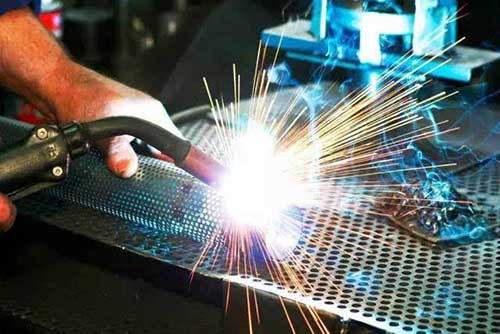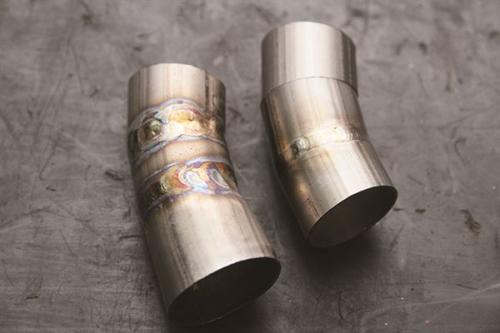Effect of chemical elements on welding of titanium(HY-industry technical centre)
Welding characteristics of titanium alloy
-
Titanium alloys have very strict protection requirements when welding. When the carbon content of the weld is 0.55%, the weld plasticity almost disappears and becomes a very brittle material. This brittleness cannot be eliminated by heat treatment after welding.
-
 There are many elements in titanium alloys, which have an effect on the physical properties of titanium. Among them, carbon is a common impurity in titanium and titanium alloys. When the carbon content is less than 0.13%, carbon is in alpha titanium, and the weld strength limit is slightly increased. , Plasticity decreased somewhat, but not as strong as oxygen and nitrogen. However, when the carbon content of the weld is further increased, the network of TiC appears in the weld, and the quantity increases with the increase of carbon content, which causes the weld plasticity to decrease sharply, and cracks are likely to occur under the action of welding stress.
There are many elements in titanium alloys, which have an effect on the physical properties of titanium. Among them, carbon is a common impurity in titanium and titanium alloys. When the carbon content is less than 0.13%, carbon is in alpha titanium, and the weld strength limit is slightly increased. , Plasticity decreased somewhat, but not as strong as oxygen and nitrogen. However, when the carbon content of the weld is further increased, the network of TiC appears in the weld, and the quantity increases with the increase of carbon content, which causes the weld plasticity to decrease sharply, and cracks are likely to occur under the action of welding stress. -
Defect of the welding seam of the titanium tube is due to the protective layer of argon gas formed by the argon arc welding gun when the titanium tube is welded, which can only maintain the welding pool without harmful effects of air. However, it has no protective effect on the welded seam and its surrounding area that have been solidified and near the high temperature state. The titanium tube weld and its surrounding area in this state still have a strong ability to absorb nitrogen and oxygen in the air. Oxygen absorption starts at 400°C and nitrogen absorption starts at 600°C, and the air contains a lot of nitrogen and oxygen. With the gradual increase of the oxidation level, the color change and plasticity of the weld of the titanium tube regularly change. Silvery white (no oxidation) Golden yellow (TiO, titanium starts to absorb hydrogen at about 250°C. Slightly oxidized) Blue (Ti2O3 is slightly oxidized slightly) Gray (Severely oxidized TiO2).
-
Effect of carbon: Titanium alloys are relatively stable, but in the welding process, at room temperature. Liquid droplets and molten pool metals have a strong effect of absorbing hydrogen, oxygen, and nitrogen, and in the solid state, these gases have interacted with them. As the temperature rises, the ability of titanium and titanium alloys to absorb hydrogen, oxygen, and nitrogen also increases significantly. Titanium begins to absorb hydrogen at about 250°C, absorb oxygen from 400°C, and absorb nitrogen from 600°C. These After the gas is absorbed, it will directly cause the embrittlement of the welded joint, which is an extremely important factor affecting the welding quality.
-
 Effect of hydrogen: The main reason is that with the increase of hydrogen content, hydrogen is the most serious factor affecting the mechanical properties of titanium among gas impurities. The change of hydrogen content in the weld seam has the most significant effect on the weld impact performance. The plate-like or needle-like TiH2 precipitated in the weld increased. The strength of TiH2 is very low, so the effect of sheet or needle-shaped HiH2 is notched, and the combined impact performance is significantly reduced; the change of hydrogen content of the weld seam has no obvious effect on the improvement of strength and the reduction of plasticity.
Effect of hydrogen: The main reason is that with the increase of hydrogen content, hydrogen is the most serious factor affecting the mechanical properties of titanium among gas impurities. The change of hydrogen content in the weld seam has the most significant effect on the weld impact performance. The plate-like or needle-like TiH2 precipitated in the weld increased. The strength of TiH2 is very low, so the effect of sheet or needle-shaped HiH2 is notched, and the combined impact performance is significantly reduced; the change of hydrogen content of the weld seam has no obvious effect on the improvement of strength and the reduction of plasticity. -
Effect of oxygen: The hardness and tensile strength of the weld are significantly increased. The oxygen content of the weld basically increases linearly with the increase of the oxygen content in the argon gas and increases with the oxygen content of the weld. The plasticity is significantly reduced. In order to ensure the performance of the welded joint, the welding seam and welding heat should be strictly prevented from being oxidized during the welding process.
-
Effect of nitrogen: Nitrogen and titanium plate have a dramatic effect at high temperature above 700℃. The formation of brittle and hard titanium nitride (TiN and the formation of interstitial solid solution between nitrogen and titanium is more serious than the equivalent amount of oxygen. Therefore, nitrogen improves the resistance of industrial pure titanium welds Tensile strength, hardness, and plasticity of the weld are more significant than oxygen. When the nitrogen content of the weld is more than 0.13%, the weld is cracked due to excessive brittleness.

